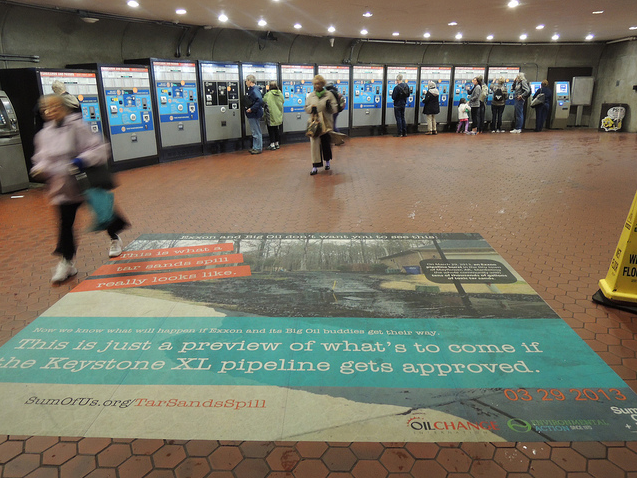Ad campaign puts Arkansas oil spill images before Keystone XL decision makers

An ad campaign featuring images of Exxon Mobil's Arkansas oil spill disaster is targeting the federal regulators in charge of approving the controversial Keystone XL pipeline project.
The consumer watchdog group SumOfUs.org has joined with Oil Change International and Environmental Action to place ads in the Washington, D.C. metro system with images of the tar sands pipeline spill that occurred last month in Mayflower, Ark. That disaster involved the rupture of Exxon's Pegasus pipeline and spilled somewhere between 150,000 and 210,000 gallons of tar sands oil in a residential neighborhood near Lake Conway, a popular fishing spot near Little Rock.
The ads will run for a month at the Foggy Bottom metro station, which is used by many State Department employees. The State Department is currently reviewing public comments on its draft environmental review of TransCanada's Keystone XL pipeline, which would transport tar sands oil from Canada to Gulf Coast refineries.
"Exxon thought it could keep us from finding out what a tar sands spill looked like by pushing the FAA to institute a no-fly zone and threatening reporters with arrest," said SumOfUs.org campaign manager Kaytee Riek, pointing to the oil giant's efforts to limit media coverage of the Arkansas disaster. "Then over 2,000 people donated to make sure the photos that leaked out ended up exactly where it didn't want them: in front of State Department employees deciding this month to approve or reject the Keystone XL tar sands pipeline."
People who live near the Mayflower disaster site have complained about foul smells from the spill as well as health effects including hives, nose bleeds and respiratory problems. Louisiana-based chemist and environmental health advocate Wilma Subra analyzed air and water monitoring data from the spill area and found the presence of cancer-causing benzene.
The type of oil that spilled in Mayflower -- and which would be transported by the Keystone XL pipeline -- is known as "diluted bitumen" or "dilbit," a type of heavy oil extracted from the tar sands. Pipelines that transport dilbit have to operate at higher temperatures, which increase corrosion and thus the likelihood of spills. The Natural Resources Defense Council reports that pipelines in the northern Midwest carrying dilbit have spilled 3.6 times more oil than the average U.S. pipeline from 2010 to 2012. And when dilbit spills, it is more damaging and difficult to clean up than conventional crude.
Last week, the Environmental Protection Agency sent a letter to State Department officials criticizing their draft environmental impact statement released in March as "insufficient" and accusing it of downplaying the pipeline's potential hazards, including spills. The State Department is responsible for approving the pipeline because it crosses an international border.
Once State is through reviewing all of the public comments, it will finalize its draft report; 90 days after that, it will determine whether the project is in the U.S. national interest.
President Obama will then have the final say on whether to allow the pipeline project to proceed. That decision is expected some time this summer.
Tags
Sue Sturgis
Sue is the former editorial director of Facing South and the Institute for Southern Studies.
